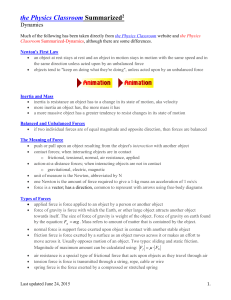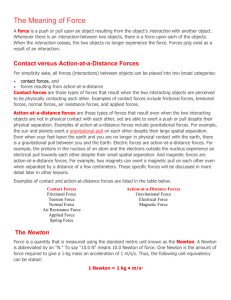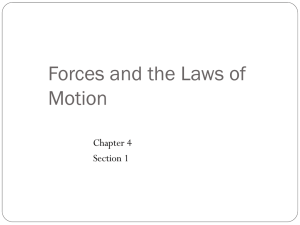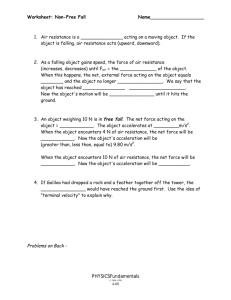Introduction to Forces Reading
advertisement
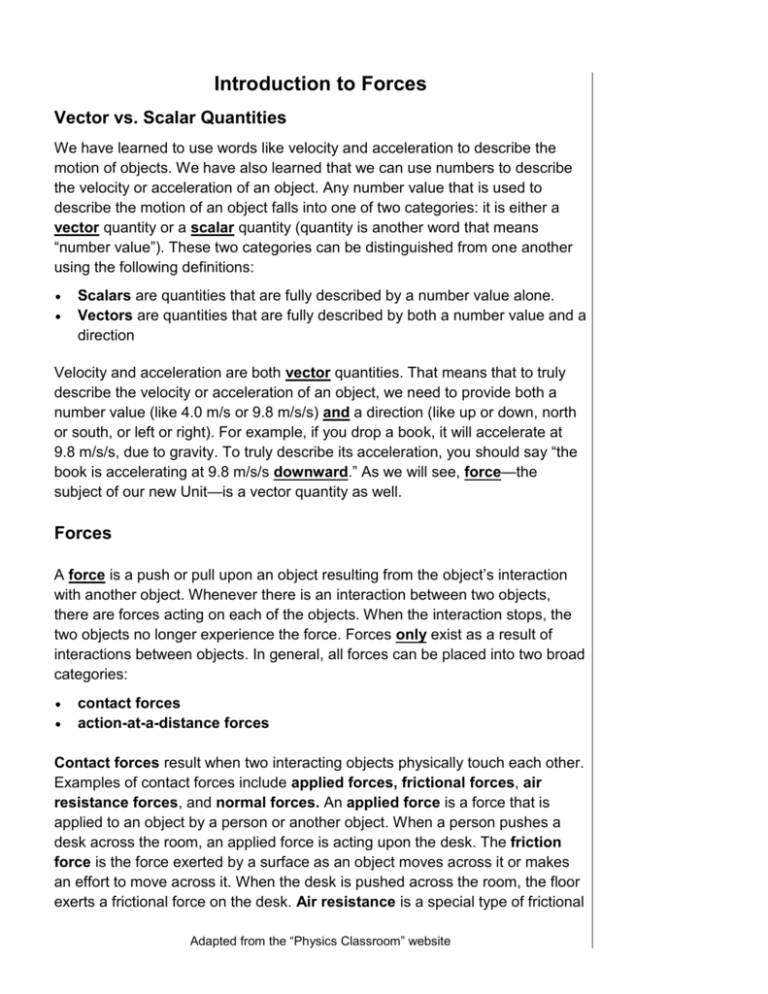
Introduction to Forces Vector vs. Scalar Quantities We have learned to use words like velocity and acceleration to describe the motion of objects. We have also learned that we can use numbers to describe the velocity or acceleration of an object. Any number value that is used to describe the motion of an object falls into one of two categories: it is either a vector quantity or a scalar quantity (quantity is another word that means “number value”). These two categories can be distinguished from one another using the following definitions: Scalars are quantities that are fully described by a number value alone. Vectors are quantities that are fully described by both a number value and a direction Velocity and acceleration are both vector quantities. That means that to truly describe the velocity or acceleration of an object, we need to provide both a number value (like 4.0 m/s or 9.8 m/s/s) and a direction (like up or down, north or south, or left or right). For example, if you drop a book, it will accelerate at 9.8 m/s/s, due to gravity. To truly describe its acceleration, you should say “the book is accelerating at 9.8 m/s/s downward.” As we will see, force—the subject of our new Unit—is a vector quantity as well. Forces A force is a push or pull upon an object resulting from the object’s interaction with another object. Whenever there is an interaction between two objects, there are forces acting on each of the objects. When the interaction stops, the two objects no longer experience the force. Forces only exist as a result of interactions between objects. In general, all forces can be placed into two broad categories: contact forces action-at-a-distance forces Contact forces result when two interacting objects physically touch each other. Examples of contact forces include applied forces, frictional forces, air resistance forces, and normal forces. An applied force is a force that is applied to an object by a person or another object. When a person pushes a desk across the room, an applied force is acting upon the desk. The friction force is the force exerted by a surface as an object moves across it or makes an effort to move across it. When the desk is pushed across the room, the floor exerts a frictional force on the desk. Air resistance is a special type of frictional Adapted from the “Physics Classroom” website force that acts upon objects as they travel through the air. The normal force is the support force exerted upon an object that is in contact with another stable object. For example, if a book is resting on a table, then the table is exerting an upward force upon the book in order to support the weight of the book. Action-at-a-distance forces are forces that result even when the two interacting objects are not in physical contact with each other, yet are able to exert a push or pull despite their physical separation. An example of an actionat-a-distance force is the gravitational force. Gravity pulls on a rock dropped from a high building, even though the rock and the Earth are not touching. When you jump up, and your feet leave the Earth, there is a gravitational pull between you and the Earth (which is why you come back down). Magnetic forces are also action-at-a-distance forces. For example, a magnet can pull on metal object like a paper clip, even when the magnet and the paper clip are not touching. The Newton All of the measurements scientists make—including measurements of force— must include a unit. Force is measured using a unit called the Newton. The abbreviation for a Newton is N. One Newton (N) is the amount of force required to give an object with a mass of 1.0 kg an acceleration of 1.0 m/s/s. A Newton is equal to one kilogram, multiplied by 1 meter per second per second: 1 Newton (N) = 1 kg • m/s/s Force is a vector quantity. Remember, a vector quantity is a quantity that has both a number value and a direction. To fully describe the force acting upon an object, you must describe size or number value of the force, and the direction of the force. “A force of 10.0 Newton” is not a complete description of the force acting upon an object. However, “A force of 10.0 Newton, left” is a complete description of the force acting upon an object, because both the number value and the direction are included. Balanced and Unbalanced Forces Because forces are vectors, the effect of one force on an object is often canceled by the effect of another force. For example, imagine a Physics book sitting on a table (see picture to right). The force of gravity is pulling the book downward. The table, on the other hand, is pushing up on the book. The effect of a 20Newton upward force acting upon a book is canceled by the effect of a 20-Newton Adapted from the “Physics Classroom” website downward force acting upon the book. When the forces that are acting on an object cancel each other out, we say that the forces are balanced. In other cases, the forces acting on an object do not cancel each other out. For example, imagine a book sliding across the rough surface of a table from left to right (see picture to right). The downward force of gravity and the upward force of the table supporting the book act in opposite directions and cancel each other. However, the force of friction pushes the book to the left, and there is no rightward force to balance it. In this case, we can say that the forces acting on the book are unbalanced. When an object experiences an unbalanced force its motion will change. In this case, the book will eventually stop sliding, due to the force of friction. If the forces acting on an object are balanced, the motion of the object will not change: it will continue to do whatever is currently doing! This is Newton’s First Law of Motion. Adapted from the “Physics Classroom” website

